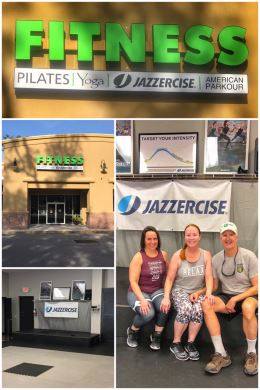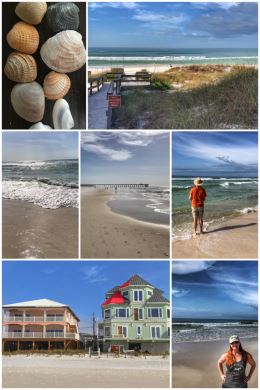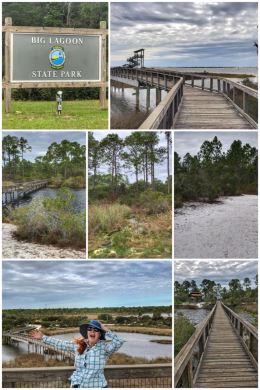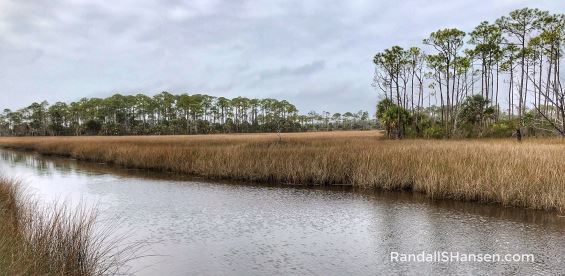
While we were sad leaving Cedar Key, we were also excited to continue the exploration of Florida… moving into our final phase by exploring areas of the Florida Panhandle, which is a strip of land roughly 200 miles long and 50 to 100 miles wide, lying between Alabama on the north and the west, Georgia on the north, and the Gulf of Mexico to the south.
We started this leg of the trip in Tallahassee, the state capitol and home of Florida State University (where Ran earned his doctorate in marketing). We were very excited to discover the city has a weekly farmers market on Saturdays — and even more excited when we saw the list of vendors, many of which sold grass-fed, pastured meats (chicken, turkey, beef, and pork). We left with a big bag full of two dozen farm-fresh eggs, several packages of ground beef, a selection of beef filets, a package of ground turkey, several pork chops, and two packages of organic microgreens/sprouts…. a wonderful haul! We especially loved Crooked Row Farm, New Green Organiks, and Orchard Pond Organics. If you want better health, you need to eat real food — and often the best and freshest comes right from your local farmers market… so eat well and support your neighbor-farmers!
The day prior, we hiked the entire Lake Overstreet Trail Loop (5.75 miles) at Maclay Gardens State Park, which Ran never got to visit while working on his doctorate degree. The 1,176-acre Maclay Gardens is both a botanical garden and a historic site. We actually parked at the Forestmeadows Trailhead (next to the Forest Meadows Athletic Center) at Elinor Klapp Phipps Park, a 670-acre tract of land on the eastern shore of Lake Jackson that also has an extensive system of trails. That park is located on the west side of Maclay Gardens and offers parking and easy access to the Maclay trails (which has an honor-based entrance fee station located there). The Lake Overstreet Trail is a fairly easy loop through woodlands, but with only limited views of the lakes and ponds. It’s a multi-purpose trail and we encountered runners, bikers, and other hikers.

Because much of the weather was stormy and rainy when we visited Tallahassee, we decided it was time to find another Jazzercise so that we could get our dance and exercise fix!
The Jazzercise Tallahassee Killearn Lakes Taekwondo center is located in the northern section of the city and offers a multitude of classes. We thoroughly enjoyed getting our sweat on with Betty (our instructor and owner of the studio). It’s a beautiful facility and was exactly what we needed! Jazzercise incorporates
cardio dance moves with strength training for a truly perfect workout!
Afterward, we headed over to the Tallahassee Costco Wholesale (Store #1016) for another fun experience filling our tank with lower-cost gas and picking up various grocery supplies (such as wonderful Mexican avocados and our beloved salted Macadamia Nuts and Pistachios).

The next day the weather cleared enough so that we could visit another wildlife refuge — one of the oldest in the U.S.
St. Marks National Wildlife Refuge, established in 1931 as a wintering ground for migratory birds, is located 25 miles south of Tallahassee and protects about 80,000 acres (spread across Wakulla, Jefferson, and Taylor counties), of which roughly 17,000 are designated wilderness.
The refuge has 43 miles along the Gulf Coast, and includes several Gulf of Mexico coastal habitats, including saltwater marshes, islands, tidal creeks, and the estuaries of seven north Florida rivers (including the St Marks River, East River, Aucilla River, and Wakula River). It is divided into four units — Wakulla, Panacea, Aucilla, and St Marks. We spent all our time in the St. Marks Unit.
Natural salt marshes, tidal flats, and human-made pools (impoundments) attract lots of birds… and we are not sure, but at least the birders in Florida do not seem to know how to drive, as people would just stop their cars in the roadway blocking traffic — as if no one existed other than themselves. Such an odd experience, much like in Yellowstone, but with far fewer interesting things to see (at least to the naked eye).
The refuge is perhaps best known (outside of birders) for the St Marks Lighthouse, the second oldest lighthouse in Florida, first constructed in 1830 for the growing port of St Marks — and located at the very south end of the refuge road. The current lighthouse dates back to 1842. In the 1930s, the Civilian Conservation Corps (CCC) built a road to the lighthouse, including setting poles and wire for electricity. During World War II, a submarine/U-Boat lookout station was located at the lighthouse. In 1960, the light in the lighthouse was automated. In the end, the lighthouse served almost two centuries — until it was decommissioned and the ownership transferred in 2013 from the Coast Guard to the U.S. Fish & Wildlife Service. Sadly, visiting the lighthouse is limited to mostly admiring it from you the outside. (The Keeper’s quarters are open for limited hours on first Friday and Saturday of each month.)
Fun Fact: The CCC also constructed the levees within the Refuge to create impoundment ponds for migratory waterfowl.
After a quick stop at the Refuge Visitor Center, we decided we would drive all the way to the lighthouse first and then work our way back north, stopping at the trails we wanted to hike. Thus, we started out with a lovely walk around the lighthouse and surrounding areas and admiring Apalachee Bay.

The Refuge has all sorts of hiking opportunities — and we decided to take advantage of several of them. You can choose trails that go through forest or swamp, across levees and marshes, or along the shore of ponds — or Apalachee Bay.
We started our hiking adventures just across the way from the lighthouse at Cedar Point Trail, a .5-mile (RT) trail that wanders through cabbage palms and red cedars before ending at the bay — near the mouths of the East River and St. Marks River.
As with most of the refuges we have visited, the land here had been used for multiple purposes and had been logged extensively before being sold to the government. Like other places in Florida, it also saw turpentine production in the area’s pine forests… and cattle and hog ranching.
We next stopped at Headquarters Pond, which offers bathrooms, a picnic area, and two trailheads for relatively short trails. We hiked both the Headquarters Pond Trail, a .5-mile accessible trail that ends at an observation deck from which we gawked at a lounging alligator, and the Tower Pond Trail, a 1-mile loop through slash pine forests, oak hammocks, and salt marsh — and named for an old (decommissioned) fire tower sitting atop an old shell mound. We found the mosquitoes on this trail fairly unrelenting… so be prepared with protection — year-round.
We ended our visit with a short hike on the Florida National Scenic Trail — which cuts through almost 50 miles within the Refuge. As mentioned in a previous post, we have strived to hike as many of the National Scenic Trails as possible — partly because of Ran’s work on the Pacific Northwest National Scenic Trail — and partly because these trails embody that spirit of getting out in nature and experiencing wilderness and backcountry.

On the way back to Tallahassee, we happily stopped at a ranch that had several donkeys in a pasture — to get a bit of donkey-love.
Donkeys and burros became our spirit animals on this trip many, many months ago toward the early stages when we were in Arizona and discovered very tame, but wild burros roaming the streets. These gentle creatures now greet us wherever we find them across the country. We discovered that many ranchers use donkeys in their fields with other livestock because donkeys are fiercely protective. We also fell in love with the legend of the donkey’s cross — in which the donkey Jesus rode into Jerusalem on Palm Sunday found Jesus where he was dying from the crucifixion… and the shadow of the cross fell upon its shoulders and back — and where it has stayed ever since.

We then traveled to Panama City and were deeply moved by how many destroyed buildings we saw, forests with the trees snapped in half, and ads touting hurricane insurance funding… only to discover that Hurricane Michael did major damage to the area.
The 2018 hurricane was the first Category 5 hurricane on record to impact the Florida Panhandle — making landfall about 25 miles southeast of Panama City near Mexico Beach (causing extensive damage, wiping out the town, as well as damaging the nearby Tyndall Air Force Base) — and was the fourth-strongest landfalling hurricane in the contiguous United States, in terms of wind speed. Panama City was not spared, as we passed by many shuttered businesses and gas stations and so many tarped roofs that we lost count… but, happily, we also saw many new buildings and the slow return of normalcy.
Bemusingly, Panama City Beach (the resort town just west of Panama City) was also the first beach we walked in this entire two years on the road… oh, sure, we have been near plenty of beaches on both coasts, but something about the sand and the sun beckoned us to walk the beach and enjoy the waves from the Gulf of Mexico, where we collected a few beautiful shells. Panama City Beach’s slogan is “The World’s Most Beautiful Beaches” due to the unusually white sandy beaches — though others know it as the Redneck Rivera, for its tacky, funky atmosphere.
We stayed at a fairly nice campground (Panama City RV Resort) located a block from the beach — and just a few blocks from St. Andrews State Park, where we enjoyed a 2-mile late afternoon walk. The park offers camping (though limited due to damage from the hurricane), sandy beaches, fishing, picnicking, hiking, snorkeling, and more. (By the way, we are so tired of RV parks using “resort” when they are nothing like a resort.)

The next day, it was back to usual for us — leaving the beach for the beautiful forested Conservation Park, located about 10 miles northwest of Panama City Beach.
The 2,912-acre park has 24 miles of trails — and more than a mile of boardwalks — that lead through Pine Flatwoods, Sand Pine Scrub, Basin Wetlands, and Cypress Dome Swamps. The trails range anywhere from 0.6 miles up to 11 miles, with 12 different trails to choose from. Yes, it is a bit confusing, but definitely fun to hike. It was on this hike that we saw our second river otter, as well as a very cool garter snake.
Interestingly, like many other areas of Florida that we have visited, the park and surrounding lands were used for turpentine production in the 1920s and 1930s. Later, tree farming took place on the land — with pine trees harvested for lumber and paper mills. Unfortunately, the landowners planted slash and sand pines (for their rapid growth), so the city has a plan to slowly harvest all those pines and reintroduce native Longleaf pine trees. While hiking, we saw much evidence of thinning and prescribed burns on the land… very cool!
We ended up hiking about 4 miles — along parts of the Yellow and Red Trails — through Cypress Pond, Buck Pond, and Palmetto. (We got a bit turned around on the Yellow Trail, but we knew we had gone too far when we hit the John Muir Trail!)

After the fun hike in nature, we rewarded ourselves with a bit more wine-tasting, having much more fun than we expected at the Panama City Beach Winery.
We actually tasted many of these wines when we visited the Naples Winery in Tin City, and found it odd that these two wineries do not seem to be affiliated, but carry the same wines and slushies. Their citrus wines are made from pure Florida citrus juice. Interestingly, it can take upwards of 9 pounds of citrus fruit to get enough juice for just one bottle of orange, grapefruit, or tangerine wine.
At Panama City Beach Winery, our server Mary was warm and wonderful, and for whatever reasons, we found the wines even better than during our first tasting… so much so that we left with a mixed case of delicious wines, including Blackberry Dry, Blueberry Dry, Orange Sunshine, Orange Coffee (a perfect combination), Blueberry Blue Sparkling, and Cranberry Sparkling.
And while there are a ton of touristy things to do in Panama City Beach — including snorkeling Shell Island, swimming with dolphins, boat and jet ski rentals, pirate cruises, golfing (regular and miniature), deep-sea fishing, dining, and shopping, we stuck with the simpler things such as hiking in nature or walking along the beach.
We ended our time in Florida in the Pensacola area where we had hoped to visit the National Naval Aviation Museum — which is the world’s largest naval aviation museum, and one of the most-visited museums in Florida. (It includes 150 beautifully restored aircraft representing Navy, Marine Corps, and Coast Guard aviation.) Sadly, because of a deadly shooting incident at the Naval Air Station Pensacola (within which the museum is housed) in December 2019, the base was still closed to civilians.

Trying not to be too discouraged, we headed over to Big Lagoon State Park, located about 16 miles southwest of Pensacola. The 705-acre park, which opened in 1978, encompasses the northern boundary of Big Lagoon as it snakes toward Pensacola Bay to the east.
Amazingly, the park features nine distinct natural communities including estuarine tidal marsh, mesic flatwoods, and wet flatwoods; it is dominated by scrubby flatwoods.
The main attractions at the park include birding, hiking, biking, fishing, camping, picnicking, and boating (canoeing or kayaking). An observation tower at East Beach offers a great view of the park, Gulf Islands National Seashore, and Perdido Key — and as you might be able to see in the picture of Jen in the photo collage, it was quite windy the day we climbed it.
Big Lagon State Park is the northwestern terminus of the 1,515-mile Florida Circumnavigational Saltwater Paddling Trail as well as a gateway site for the Great Florida Birding and Wildlife Trail (a 2,000-mile long collection of more than 500 sites of protected bird habitats).
We parked in West Beach and walked to an observation deck overlooking Big Lagoon before continuing on to Long Pond and then along the Estuary Trail to East Beach… before looping back to West Beach… for a total of almost 3 miles.
We traveled the entire perimeter of Florida (going inland occasionally), from Jacksonville in the northeast corner, down to Key West in the south, up along the Gulf Coast and through to the end of the Panhandle. Phew… and we thought Texas was a crazy long adventure!
Next up we visit Alabama briefly on our way to a Hansen Brothers reunion in Atlanta.
